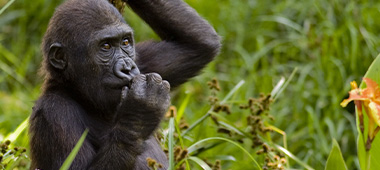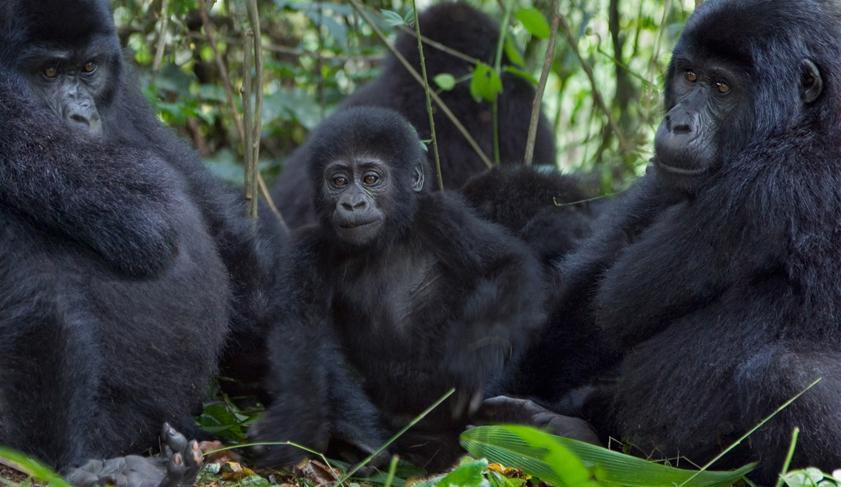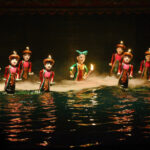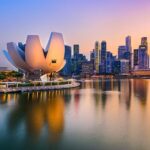Gorilla trekking… the measure of adventure
Have you ever heard of the human travel gauge? That’s when you tell someone you’re close to like your mom, grandmother, best friend etc. about your next off the wall adventure. The more shock they register, often the better and more authentic experience you will have.
My human travel gauge is my mom and telling her that I was going to see the mountain gorillas in Rwanda got a good 8.5/10. It was great news, a sign that I was in for something truly amazing.
Heading into Rwanda
The first thing we notice is the landscape. It’s hilly, green and the land looks well tended. Of the countries we have seen this one is distinct. Gone are the flat plains of Kenya and Tanzania. And it doesn’t have the red soil typical of Uganda. No wonder they call this the Switzerland of Africa.
It also makes me realize how much we’ve seen in the past few weeks on this tour. Africa has so much diversity and taking an overland trip is the ideal way to see it.
A difficult legacy
Rwanda has a complex and traumatic past. On the truck, I read Romeo Dallaire’s “Shake Hands with the Devil,” a book about the UN commander who saw the country fall helplessly into chaos. So, when we entered Rwanda, I expected this country to carry the scars of this devastation. I expected downtrodden people with dour, listless eyes.
I couldn’t have been more wrong.
Rwanda is a vibrant country that has worked hard to overcome its history. As everywhere in Africa, when we stop the truck for lunch, the first to approach are the children. They look severe for their age, but after Matt takes photos of them and shows them the images on his viewfinder, they smile.
Soon, younger children follow. They whisper amongst themselves and eye us cautiously. Again, after doing some pantomime, it’s not hard to get them laughing. Then, before we know it, the entire lunch spot seems to be teeming with people. Kids, adults, everyone is standing around, mostly smiling and chatting. They do seem a bit more reserved than in Uganda, but as soon as we approach, they smile brightly.
Curiosity and friendship are international traits.
Up to the Gorilla Trek
There are thought to be over 1000 wild mountain gorillas left in existence. Previously on the decline and close to critical danger levels, conservation and research have enabled gorilla numbers to climb in recent years. So, aside from the obvious costs of paying the guides and trackers, the permit fee I have paid will also go to conservation efforts to protect these animals.
Our base for the trip is Rhuengeri (also known as Musanze), and we’ll be staying on the grounds of a pastoral centre.
The Gorilla Permit Centre:
Our gorilla trekking day finally arrives. We’re up at 6:00 to head to the permit centre, where we will meet our guide and learn which family we will track.
There’s a palpable excitement in the air, as this is the day we’ve all waited for. The road to the permit centre is beautiful. The park’s name seems apt – Parc des Volcans houses five extinct volcanoes, and these loom overhead.
The land is verdant. Children meander down the road in packs on their way to school.
Finally, we arrived. After hanging around, we met our guide, and we grouped. There are eight permits per family and only seven of us, so we are joined by another traveller.
The silverback gorilla, Charles and his family:
Our fantastic guide shows us a placard with gorilla faces. He points to the photo at the top right. “This is Charles,” he says. We’re going to meet his family. “
We learn that Gorilla life is an absolute patriarchy. The alpha silverback – in this case, Charles – is responsible for the entire family.
Charles’ family is known as the Umubano group. The guide explains the history. “Before the genocide in 1994, Charles was part of a different family,” he reminisces. “We stopped tracking the gorillas in Rwanda in 1994 because it was too dangerous with the war. When we started again in 2001, we found that Charles had started a new family. And because the war had ended, we called the family Umubano.” He tells us the word means peace in Kinyarwanda, Rwanda’s national language.
It turns out that Charles was a renegade gorilla who saw an opportunity to run away with two females and start a new family. Fortunately, this family now has 12 members, four of whom are infants. The guide tells us we’re lucky. Charles’ family is known to be active and curious, which means we’ll likely have lots of interaction.
Preparation for Gorilla Tracking
Each day, before the tourists arrive, trackers head into the mountains to try and locate the habituated families. Trackers believe the family is about a two-hour walk from the centre. We’re told that gorillas generally only move a couple of kilometres daily. The hard part is the terrain, since it’s very dense and locating the family can involve bushwacking potentially treacherous terrain.
We load into a small truck, and the guide jokes that we’re off to get an ‘African massage’ – a euphemism for one of the most boulder-strewn roads I’ve seen
Finally, we arrive at the base of a towering, almost perfectly conical volcano. We’re given special sticks with beautifully rendered gorilla carvings at the handle. And after some initial photos, we begin our walk.
We start walking!
We start walking through farmland. He leads us over a small ditch and says this is where the park begins. It’s immediately obvious, since after the ditch, the terrain changes. Here we’re in very dense bush. There’s a thin trail, but it’s poorly maintained. And soon we realize that mixed into the bush is stinging nettle. It’s a tough balance, because it’s hot, not the weather for long clothing. But, short sleeves can lead to a sting from the nettle.
We start ascending and the path is tough. But as we’re finding our groove, the guide starts muttering to the trackers on his walkie talkie. Apparently, we’ve gone the wrong way. We descend again back to the farmland and traverse along the base of the volcano. After another half hour on farmland, we re-enter the park and resume our ascent
We climb for a couple hours. It’s a tough trek. We’re a relatively fit group but when I look back I can see some stragglers. The guide stops for a break, and I can see that Holly looks pretty wiped. We start again. And after another half hour the guide stops and points to some of the densest jungle I’ve ever seen.
Gorillas!
My partner, who has a 300-degree zoom, focuses in. “GORILLAS!!!” We look carefully at the scene and soon realise there is something there. With my zoom, I can finally make it out. There are, indeed, wild gorillas here.
The first thing I recall is that it all seemed surreal. Having such a hauntingly beautiful and serene human-like face staring back at you in the jungle seems odd, to say the least.
We only have an hour
But it is the best hour of my life. At our first sighting, the guide sets his clock. We get exactly one hour with the gorillas. He tells us to leave our bags and only bring our cameras as we follow a steep banked trail for the last 5 minutes to Charles’ family.
The next thing I remember is looking down a steep hill. Nick, who is a few paces ahead, whispers, “Gorillas, oh my god, gorillas!” Below us is a female with a baby and another young male. What amazes me is that my heart is going 1000 miles a minute while they look so peaceful, so composed. I break out my camera and start snapping madly. This first contact is one of my favourites because I hadn’t yet figured out the rules for the next hour.
The guide tells us to keep a 7-meter distance at all times. But as the young male approaches me, I quickly learn that humans impose this rule—this gorilla family hasn’t been briefed!
The guide tells us we must move, and we struggle up the steep embankment as the male quickly gains on me. Finally, I reach the flat trail, and unfazed, the gorilla pushes past me into the bush, only a couple of meters from where I’m standing.
Charles makes an appearance
The group idles forward to a flat clearing. It’s here we get our first glimpse of Charles. He’s unmistakable, on all fours, with his massive knuckles pushed against the ground. It seems that he’s posing, making his silver back towards us. He’s a fantastic display; everything about him exudes power and strength. Around him is his family. There must be four or five that are busying themselves. They chew branches and graze on vegetation while Charles stays poised on the hilltop.
Cameras are snapping, and we’re all trying to reconcile that we’re in a jungle in Rwanda and that in front of us is a family of wild gorillas. You’d be surprised how often I thought this must be some bizarre dream over the hour.
An infant in our midst
One of the little infant gorillas approaches us. The guide tells us to move back—the little guys tend to be the most curious, and he will likely get too close. There’s a strange give-and-take here. We want as close an encounter as possible, while the guide is responsible for keeping us back. But the infant (we later learn he’s three years old) comes closer and stares Matt in the eyes.
The guide starts making low grunts and waving a leaf. The little guy does an impish twirl as if showing off his latest moves. He’s like a little kid who knows he’s adorable and is keen to have adults confirm it. He stares at us with a look of curiosity; it’s not unlike what any kid does when confronted by a strange animal.
The guide hollers again. The little gorilla does another roll and then continues down the path.
Charles
A few minutes later, we have our best encounter with Charles. He’s been on the hilltop the entire time but suddenly gets up and walks towards us. It’s now that his size becomes apparent.
Until now, I haven’t feared for my safety, but I’m suddenly a bit nervous. I mean, what if this gorilla doesn’t want us here? This is, after all, his home, and we are the guests. And what does a 300-pound silverback gorilla do with unwelcome guests anyway? But the guide doesn’t urge us to move. And soon, he’s right in front of us, only a meter away. And just as he passes, he stands up, beats his chest and walks off into the bush.
We’re all a bit stunned.
Wonder all around us
The next half hour we stick to roughly the same area. We spot a mother with a tiny baby on her back. This is the youngest gorilla, only 4 months old.
We also see a gorilla swinging branch to branch in the trees. It looks like fun, I’m almost tempted to give it a try. Then the guide tells us there are 10 minutes left. We try to argue. It seems impossible that 45 minutes went by that quickly. But, he shows us his watch. For the final ten minutes, I consciously put down my camera. I’ve been so busy snapping I’ve hardly had time to appreciate what I’m seeing.
In spite of their size, these are gentle creatures. They are contented to munch on the thick vegetation while the little gorillas play. Perhaps, I think, it’s ironic that it’s me who feared the gorillas. After all, humans have brought them to the brink of extinction.
And then, in the fastest hour of my life, the guide tells us we’re done. We all try to sneak a few more minutes, but he urges us on.
It’s a tough hike back, but we’re all buzzing about our experience. And there’s one thing that we all seem to agree on: the permit fee was a bargain for the experience we had with Charles and his family.




